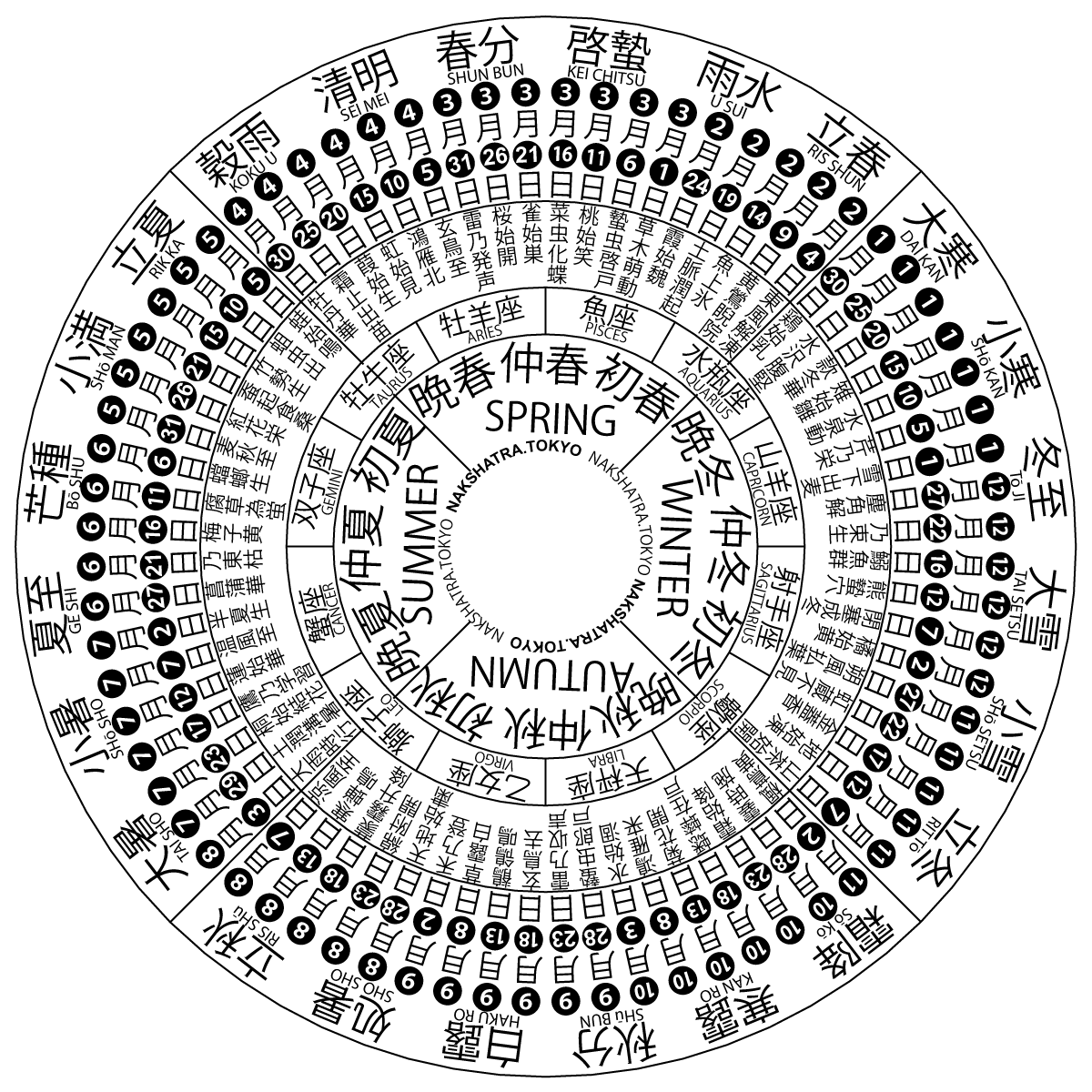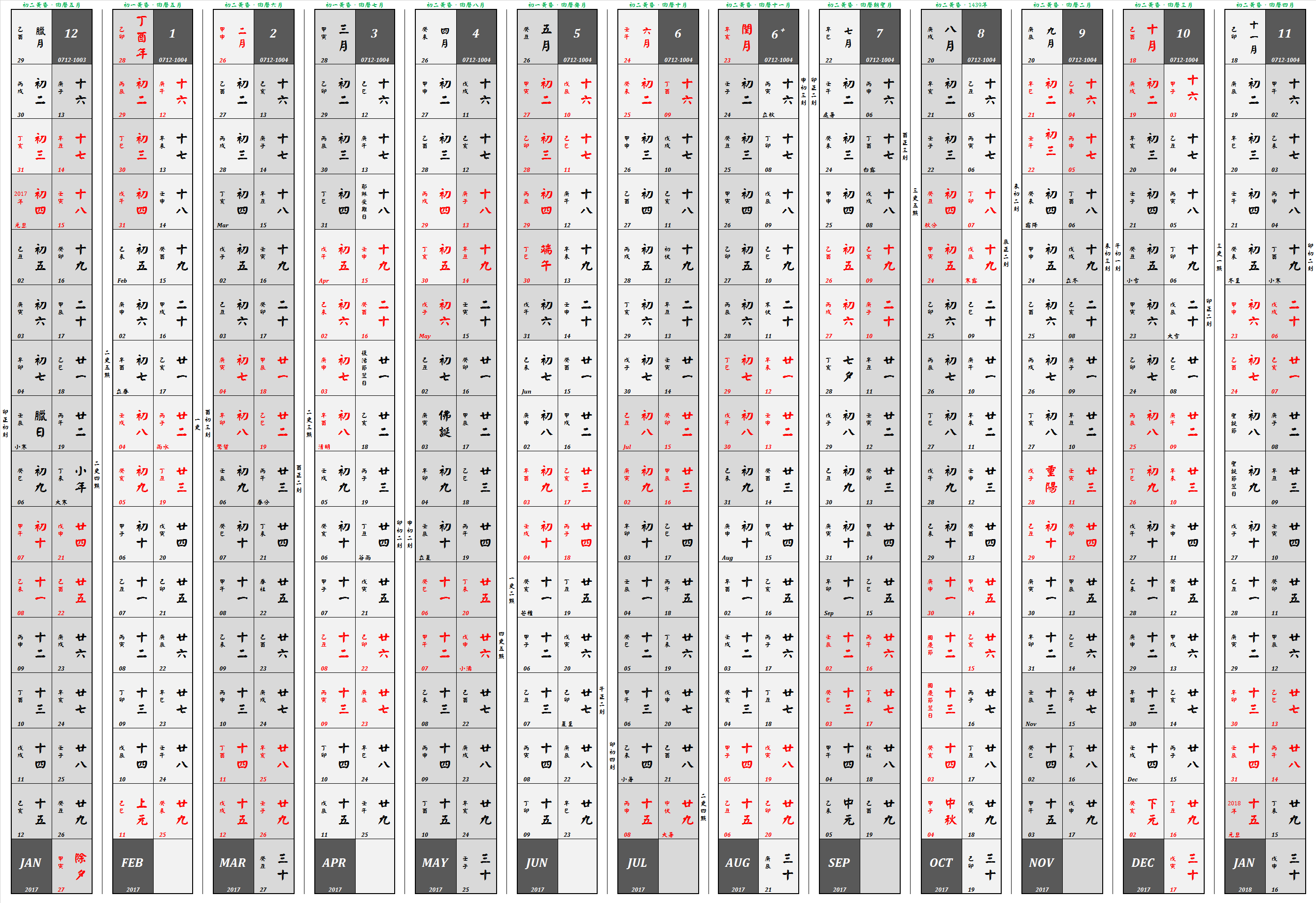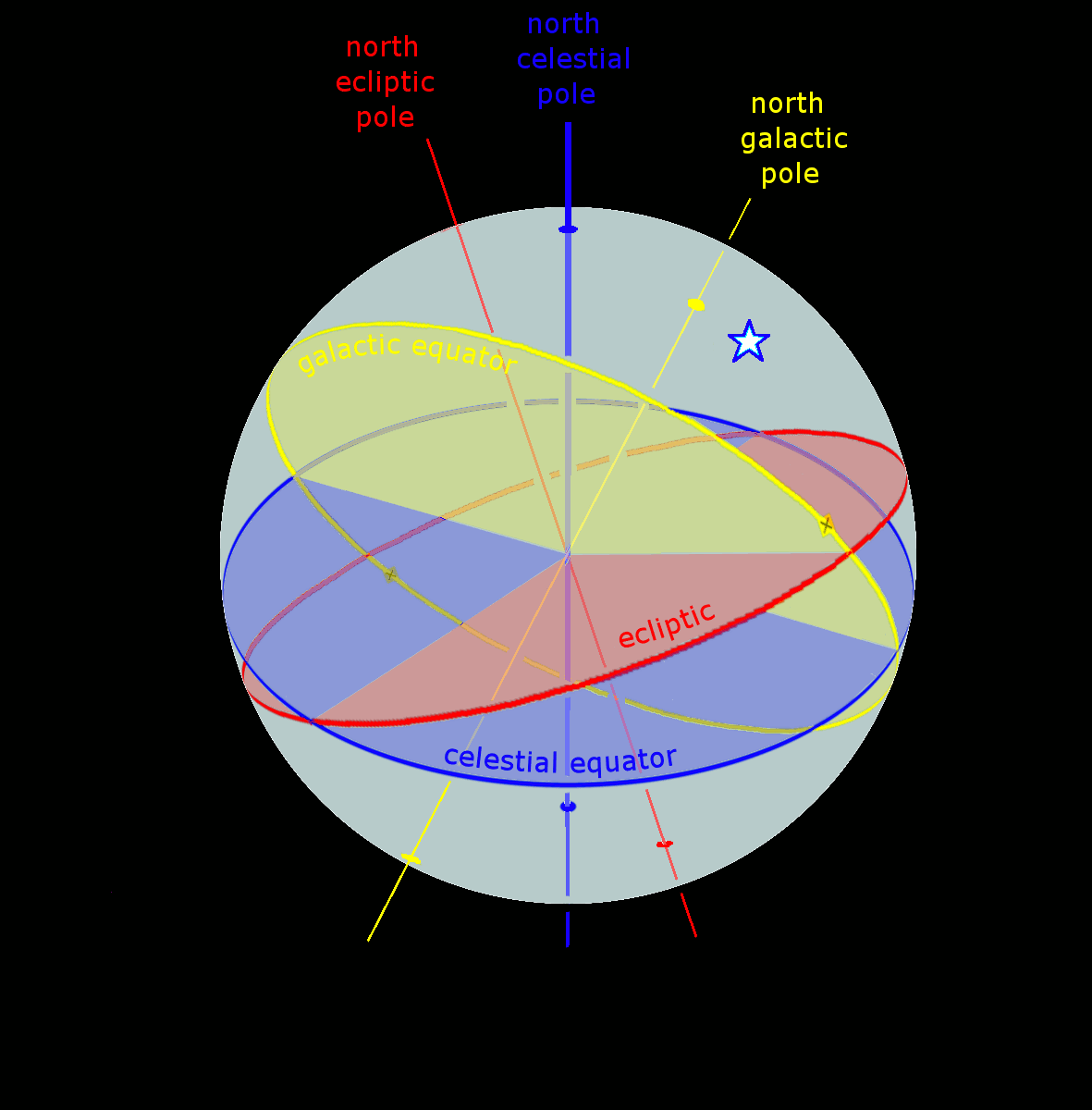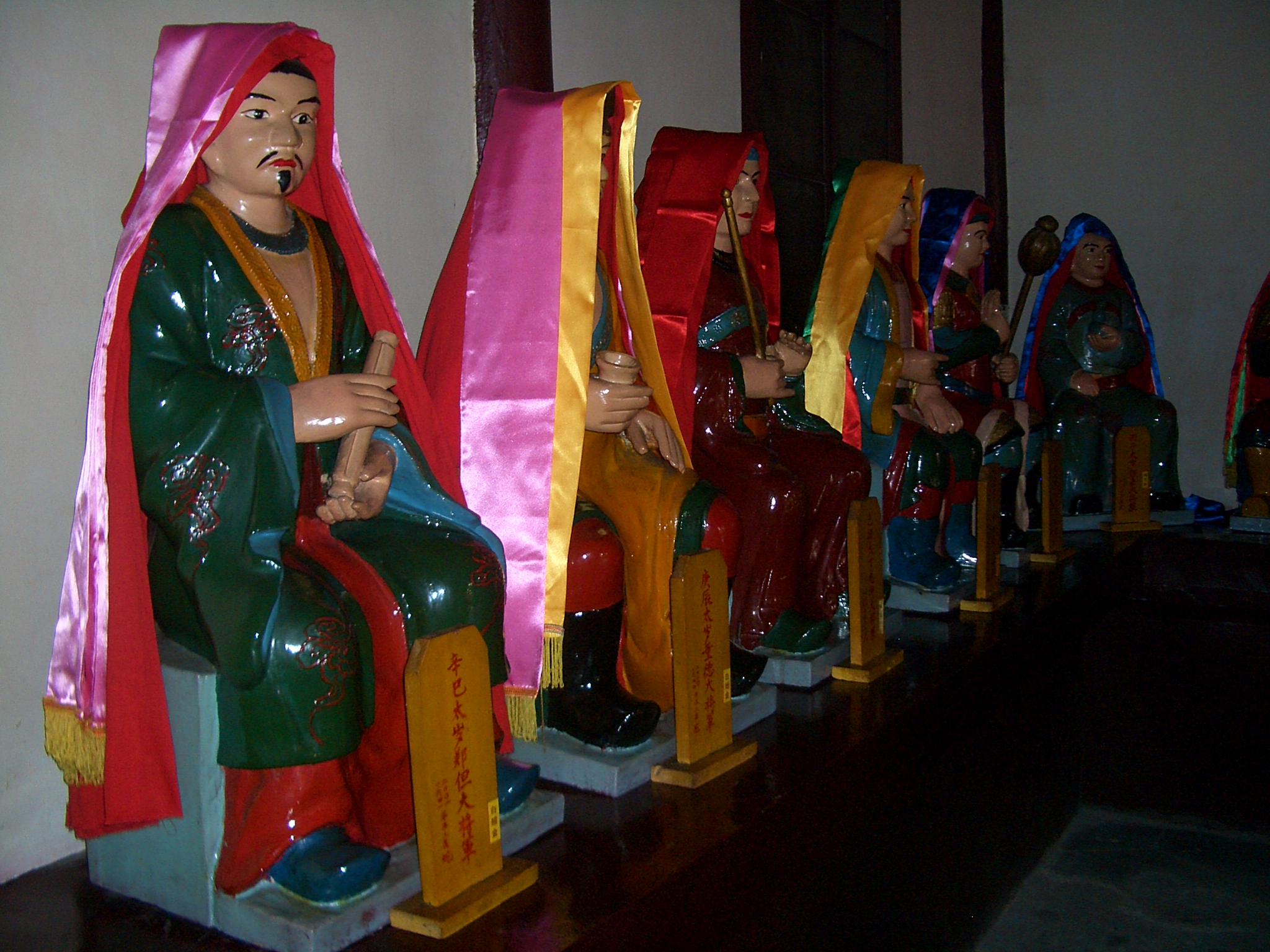|
Risshū
The traditional Chinese calendar divides a year into 24 solar terms. ''Lìqiū'', ''Risshū'', ''Ipchu'', or ''Lập thu'' () is the 13th solar term. It begins when the Sun reaches the celestial longitude of 135° and ends when it reaches the longitude of 150°. It more often refers in particular to the day when the Sun is exactly at the celestial longitude of 135°. In the Gregorian calendar The Gregorian calendar is the calendar used in most parts of the world. It was introduced in October 1582 by Pope Gregory XIII as a modification of, and replacement for, the Julian calendar. The principal change was to space leap years dif ..., it usually begins around August 7 and ends around August 23. Liqiu signifies the beginning of autumn in East Asian cultures. Date and time References {{s-end Autumn 13 ... [...More Info...] [...Related Items...] OR: [Wikipedia] [Google] [Baidu] |
|
 |
Solar Term
A solar term is any of twenty-four periods in traditional Chinese calendar, Chinese lunisolar calendars that matches a particular astronomical event or signifies some natural phenomenon. The points are spaced 15° apart along the ecliptic and are used by lunisolar calendars to stay synchronized with the seasons, which is crucial for agrarian societies. The solar terms are also used to calculate Intercalation (timekeeping), intercalary months; which month is repeated depends on the position of the sun at the time. According to the ''Book of Documents'', the first determined term was Dongzhi (solar term), Dongzhi (Winter Solstice) by Duke of Zhou, Dan, the Duke of Zhou, while he was trying to locate the geological center of the Western Zhou dynasty, by measuring the length of the sun's shadow on an ancient timekeeper instrument named Tu Gui (土圭). Then four terms of seasons were set, which were soon evolved as eight terms; until 104 BC in the book Taichu Calendar, the entire twe ... [...More Info...] [...Related Items...] OR: [Wikipedia] [Google] [Baidu] |
|
:Category:Chinese Words And Phrases
This category is for articles on words and phrases of Chinese origin. For articles on words and phrases related to a specific area of China, or to a specific spoken variant, please refer to one of the subcategories. Words A word is a basic element of language that carries an objective or practical meaning, can be used on its own, and is uninterruptible. Despite the fact that language speakers often have an intuitive grasp of what a word is, there is no conse ... Words and phrases by language {{CatAutoTOC ... [...More Info...] [...Related Items...] OR: [Wikipedia] [Google] [Baidu] |
|
 |
Chinese Calendar
The traditional Chinese calendar (also known as the Agricultural Calendar ��曆; 农历; ''Nónglì''; 'farming calendar' Former Calendar ��曆; 旧历; ''Jiùlì'' Traditional Calendar ��曆; 老历; ''Lǎolì'', is a lunisolar calendar which identifies years, months, and days according to astronomical phenomena. In China, it is defined by the Chinese national standard GB/T 33661–2017, "Calculation and Promulgation of the Chinese Calendar", issued by the Standardization Administration of China on May 12, 2017. Although modern-day China uses the Gregorian calendar, the traditional Chinese calendar governs holidays, such as the Chinese New Year and Lantern Festival, in both China and overseas Chinese communities. It also provides the traditional Chinese nomenclature of dates within a year which people use to select auspicious days for weddings, funerals, moving or starting a business. The evening state-run news program '' Xinwen Lianbo'' in the P.R.C. continues to anno ... [...More Info...] [...Related Items...] OR: [Wikipedia] [Google] [Baidu] |
 |
Celestial Longitude
Astronomical coordinate systems are organized arrangements for specifying positions of satellites, planets, stars, galaxies, and other celestial objects relative to physical reference points available to a situated observer (e.g. the true horizon and north cardinal direction to an observer situated on the Earth's surface). Coordinate systems in astronomy can specify an object's position in three-dimensional space or plot merely its direction on a celestial sphere, if the object's distance is unknown or trivial. Spherical coordinates, projected on the celestial sphere, are analogous to the geographic coordinate system used on the surface of Earth. These differ in their choice of fundamental plane, which divides the celestial sphere into two equal hemispheres along a great circle. Rectangular coordinates, in appropriate units, have the same fundamental () plane and primary (-axis) direction, such as a rotation axis. Each coordinate system is named after its choice of fund ... [...More Info...] [...Related Items...] OR: [Wikipedia] [Google] [Baidu] |
 |
Gregorian Calendar
The Gregorian calendar is the calendar used in most parts of the world. It was introduced in October 1582 by Pope Gregory XIII as a modification of, and replacement for, the Julian calendar. The principal change was to space leap years differently so as to make the average calendar year 365.2425 days long, more closely approximating the 365.2422-day 'tropical' or 'solar' year that is determined by the Earth's revolution around the Sun. The rule for leap years is: There were two reasons to establish the Gregorian calendar. First, the Julian calendar assumed incorrectly that the average solar year is exactly 365.25 days long, an overestimate of a little under one day per century, and thus has a leap year every four years without exception. The Gregorian reform shortened the average (calendar) year by 0.0075 days to stop the drift of the calendar with respect to the equinoxes.See Wikisource English translation of the (Latin) 1582 papal bull '' Inter gravissimas''. Second ... [...More Info...] [...Related Items...] OR: [Wikipedia] [Google] [Baidu] |
 |
Coordinated Universal Time
Coordinated Universal Time or UTC is the primary time standard by which the world regulates clocks and time. It is within about one second of mean solar time (such as UT1) at 0° longitude (at the IERS Reference Meridian as the currently used prime meridian) and is not adjusted for daylight saving time. It is effectively a successor to Greenwich Mean Time (GMT). The coordination of time and frequency transmissions around the world began on 1 January 1960. UTC was first officially adopted as CCIR Recommendation 374, ''Standard-Frequency and Time-Signal Emissions'', in 1963, but the official abbreviation of UTC and the official English name of Coordinated Universal Time (along with the French equivalent) were not adopted until 1967. The system has been adjusted several times, including a brief period during which the time-coordination radio signals broadcast both UTC and "Stepped Atomic Time (SAT)" before a new UTC was adopted in 1970 and implemented in 1972. This change ... [...More Info...] [...Related Items...] OR: [Wikipedia] [Google] [Baidu] |
 |
Sexagenary Cycle
The sexagenary cycle, also known as the Stems-and-Branches or ganzhi ( zh, 干支, gānzhī), is a cycle of sixty terms, each corresponding to one year, thus a total of sixty years for one cycle, historically used for recording time in China and the rest of the East Asian cultural sphere. It appears as a means of recording days in the first Chinese written texts, the Shang oracle bones of the late second millennium BC. Its use to record years began around the middle of the 3rd century BC. The cycle and its variations have been an important part of the traditional calendrical systems in Chinese-influenced Asian states and territories, particularly those of Japan, Korea, and Vietnam, with the old Chinese system still in use in Taiwan, and to a lesser extent, in Mainland China. This traditional method of numbering days and years no longer has any significant role in modern Chinese time-keeping or the official calendar. However, the sexagenary cycle is used in the names of many histo ... [...More Info...] [...Related Items...] OR: [Wikipedia] [Google] [Baidu] |
 |
JPL Horizons On-Line Ephemeris System
JPL Horizons On-Line Ephemeris System provides access to key Solar System data and flexible production of highly accurate ephemerides for Solar System objects. Osculating elements at a given epoch (such as produced by the JPL Small-Body Database) are always an approximation to an object's orbit (i.e. an unperturbed conic orbit or a " two-body" orbit). The real orbit (or the best approximation to such) considers perturbations by all planets, a few of the larger asteroids, a few other usually small physical forces, and requires numerical integration. Jet Propulsion Laboratory (JPL) ephemerides do not use things such as periods, eccentricities, etc. Instead, JPL integrates the equations of motion in Cartesian coordinates (x,y,z), and adjusts the initial conditions in order to fit modern, highly accurate measurements of planetary positions. Since August 2013, Horizons has been using ephemeris DE431. During the week of 12 April 2021, the Horizons ephemeris system was updated ... [...More Info...] [...Related Items...] OR: [Wikipedia] [Google] [Baidu] |
|
Dashu (solar Term)
The traditional Chinese calendar divides a year into 24 solar terms. ''Dàshǔ'' (), ''Taisho'', ''Daeseo'', or ''Đại thử'' (Chinese and Japanese: 大暑; pinyin: ''dàshǔ''; rōmaji: ''taisho''; Korean: 대서; romaja: ''daeseo''; Vietnamese: ''đại thử''; "major heat") is the 12th solar term. It begins when the Sun reaches the celestial longitude of 120° and ends when it reaches the longitude of 135°. It more often refers in particular to the day when the Sun is exactly at the celestial longitude of 120°. In the Gregorian calendar The Gregorian calendar is the calendar used in most parts of the world. It was introduced in October 1582 by Pope Gregory XIII as a modification of, and replacement for, the Julian calendar. The principal change was to space leap years dif ..., it usually begins around 22 July (23 July Chinese lunisolar calendar time) and ends around 7 August. Date and time References {{Use dmy dates, date=September 2011 12 Summer< ... [...More Info...] [...Related Items...] OR: [Wikipedia] [Google] [Baidu] |
|
|
Chushu
The traditional Chinese calendar divides a year into 24 solar terms. ''Chǔshǔ'', ''Shosho'', ''Cheoseo'', or ''Xử thử'' () is the 14th solar term that signifies the end of the hot summer season. It begins when the Sun reaches the celestial longitude of 150° and ends when it reaches the longitude of 165°. It more often refers in particular to the day when the Sun is exactly at the celestial longitude of 150°. In the Gregorian calendar The Gregorian calendar is the calendar used in most parts of the world. It was introduced in October 1582 by Pope Gregory XIII as a modification of, and replacement for, the Julian calendar. The principal change was to space leap years dif ..., it usually begins around 23 August and ends around 7 September. Pentads *鷹乃祭鳥, 'Eagles worship the Birds' *天地始肅, 'Heaven and Earth begin to Withdraw', alluding to the end of summer *禾乃登, 'Grains become Ripe' Date and time References {{s-end Autumn 14 [...More Info...] [...Related Items...] OR: [Wikipedia] [Google] [Baidu] |
|
 |
Autumn
Autumn, also known as fall in American English and Canadian English, is one of the four temperate seasons on Earth. Outside the tropics, autumn marks the transition from summer to winter, in September (Northern Hemisphere) or March ( Southern Hemisphere). Autumn is the season when the duration of daylight becomes noticeably shorter and the temperature cools considerably. Day length decreases and night length increases as the season progresses until the Winter Solstice in December (Northern Hemisphere) and June (Southern Hemisphere). One of its main features in temperate climates is the striking change in colour for the leaves of deciduous trees as they prepare to shed. Date definitions Some cultures regard the autumnal equinox as "mid-autumn", while others with a longer temperature lag treat the equinox as the start of autumn. In the English-speaking world of high latitude countries, autumn traditionally began with Lammas Day and ended around Hallowe'en, the app ... [...More Info...] [...Related Items...] OR: [Wikipedia] [Google] [Baidu] |